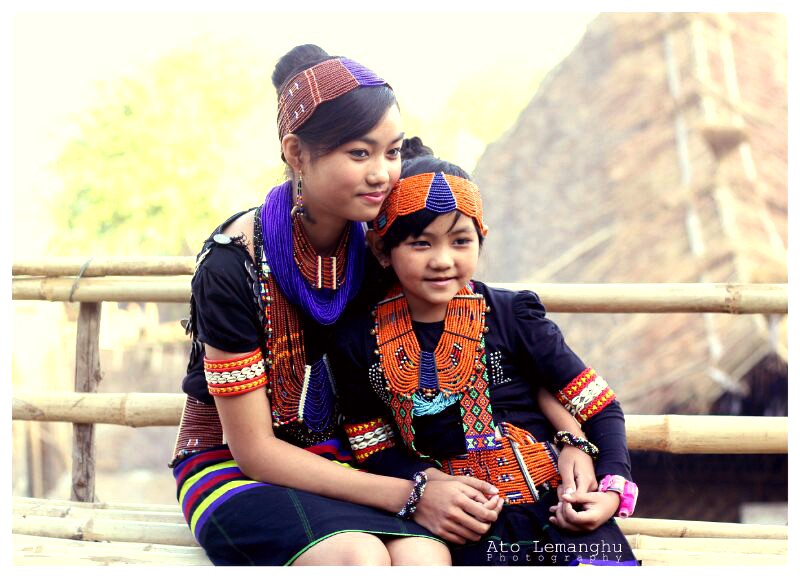Young Konyak Naga girls in their traditional fineries. (Photo by: Ato Lemanghu)

Naro Longchar
Kohima | February 26
Kohima | February 26
Puffing the smoking pipe with red lips from chewing ‘tamul,’ she would walk ever so slowly for any mundane task. But the one thing that I remember distinctly about my grandmother was the traditional jewelry and clothes she adorned herself with. Her ears lobes drooped down low from the weight of the heavy white traditional earrings; the traditional Ao necklace (red bead with alternate bell shaped brass) around her neck and the red and blue Ao mekhala wrapped around her waist was her everyday getup. As a child I would stare at her sagging earlobes, and wonder if it hurt and why she would go to such lengths for an earring.
Of course I did not realize then that she was born into an era where the now ‘traditional’ attire was an everyday getup and very much a part of being a naga woman. Wearing a pant or anything other than the mekhala would have been completely unthinkable or even a ‘taboo’. Over the years with the advent of Christianity and ‘modernization,’ the modern Naga woman is but a whisper of what she used to be. In a male dominant society she has blossomed into a strong, independent woman and work efficient outfits have replaced the traditional wear.
Our traditional attire has more of a formal feel and is not very comfortable for everyday wear unlike ‘Jainsem’, the traditional attire of Meghalaya. A two piece garment which is the basic everyday outfit of almost all women folk there and ‘Jain-kyrshah’, a checkered cotton cloth knotted over one shoulder; sort of an improvised apron for home wear.
With changing times, comes a need to adapt. If history is any indication, civilizations have been lost or suppressed because they refused to change and instead clung on to their traditional ways.
Having said that, our past and our traditions constitute our identity and preserving them is preserving ‘who we are’. Many in the younger generation do not even know how to wrap a mekhala around their waist or to walk around wearing it.
Wearing traditional attires should not become a societal issue imposed through some authority, a certain group or an organization. One should wear it because one wants to and is proud of what it stands for. It should come from within a home; simple things like a mother teaching her daughter on how to wear a mekhala; passing on the rich tradition, so that years down the line, things do not come to such a point that an internet search on ‘how to wear a mekhala’ is needed.
Maybe my grandmother went to the lengths of wearing the heavy traditional earrings and the uncomfortable getup everyday because she was used to it or maybe because it was her way of clinging on to the past when everything around her was changing, replaced by something alien. Or maybe the getup was a part of who she was, the essence of a complete Naga woman.






